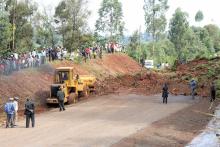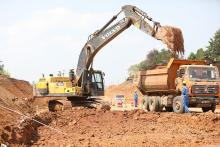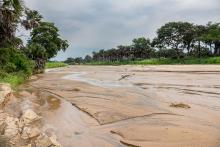
Construction of new infrastructure in Kenya has created a huge demand for sand and gravel, forcing some consumers and suppliers to look for these materials in areas considered to have environmentally delicate ecosystems. Shem Oirere reports.
The Indian Ocean seabed and riverbanks have become the latest sources of sand and gravel as the inland quarry sources across the country are reportedly getting exhausted because of uncontrolled and unregulated harvesting of this critical construction material. The scramble for sand and gravel is meant to satisfy demand for land reclamation to expand Kenya’s port infrastructure, especially the port of Mombasa; a number of the country’s asphalt pavements; and the ongoing national experimentation with concrete roads.
Construction of the US$3.6 billion standard gauge railway (SGR) line linking the port city of Mombasa to the capital Nairobi has become the latest mega infrastructure project to push up the demand for sand and gravel as the contractor seeks the material to make concrete rail sleepers and T-beams to reinforce the almost-30km of bridges along the 609km modern railway stretch.
The sleepers and T-beams are produced at two recently completed factories, at Emali and Kathekani in Kenya’s former Eastern province.
Earlier, there were unconfirmed media reports indicating that the construction of the standard gauge railway and a new terminal at the port of Mombasa will consume an estimated five million tonnes of sand dredged from the seabed near Diani beach.
According to the United Nations Environment Programme past study, for each tonne of cement used in construction, the building industry needs about six to seven times more tonnes of sand and gravel.
Some of the sand and gravel for the railway project is obtained from Kenya’s south coast near the world-famous Diani beach in Kwale County with local leaders, NGOs and communities claiming the dredging for sand is posing an environmental hazard and should be con-trolled, if not stopped completely.
Kwale County governor Mr Salim Mvurya says the sand harvesting off Kenya’s south coast for the construction of the railway and also for the construction of a cargo terminal at the Mombasa Port “will destroy the beaches and reefs, kill marine life, cause pollution, and take away livelihoods of fishermen and ultimately turn tourists away.”
Mvurya adds: “By removing sand across from the reef, the topography and hydrology of the area changes and the tides take the sand from beaches to fill the gaps created by the dredging, resulting in sandless but rocky beaches, as has already happened in the Sand Island in the south coast’s Tiwi area.”
The governor argues that the harvesting of the sand in the coastal region is “harming marine life, the churned up sand settles on the reef, killing the coral, yet coral reefs are the most diverse and valuable ecosystems on earth.”
However, with the absence of national data on sand and gravel mining, it is not easy to establish with precision how much of the construction material is being obtained from the seabed of Kenya’s part of the Indian Ocean.
However, Mvurya and environmental NGOs have expressed fear over the likely negative impact of unregulated sand harvesting, especially on the Diani beaches, a major tourist attraction.
“Sand harvesting will kill marine lives, cause pollution and destroy our beaches,” says Mvurya. He said the livelihoods of fishermen in Tiwi, Diani and Kinondo areas are at stake unless an environmentally sustainable sand harvesting strategy is embraced by construction companies and suppliers.
In addition, Mvurya argues the harvested sand will need to be washed at Port Reitz in Kwale to remove the salt using fresh water, before it is used in construction. The removal of the salt from the marine aggregates is important to ensure concrete structures built with it do not collapse because of the corrosion of the inbuilt metal structures.
An NGO, the South Coast Residents Association, said in a statement “the taking of ocean sand and washing it in Mombasa, where there is already a shortage of water, is very costly.”
“Sea sand needs to be washed with fresh water, an equally scarce resource at the Coast, and if millions of tonnes of salty sand have to undergo such treatment, it is everyone’s guess whose water pipes will go dry while the ‘washing’ goes on.”
According to Kwale National Environmental Management Authority (Nema) director George Oyoo, there is no law banning marine sand dredging so long as the dredging is done in accordance with environmental law.
He was quoted by local media saying the marine sand dredging off Diani beach was stopped in November last year because “we discovered that the company involved had not conducted an Environmental Impact Assessment contrary to Nema regulations.”
According to the Kenya Ports Authority Masterplan, not all the marine sand dredging operations in Kenya’s coast region have raised eyebrows. The construction of the 300,000 twenty-foot equivalent unit (TEU) capacity second container terminal at the port of Mombasa consumed 20 million tonnes of sand and 400 tonnes of stones scooped from the deep sea “to create dry land along the Indian Ocean and space for the terminal”. The terminal has just been completed and officially commissioned for operations.
The $66 million terminal is the first phase of three terminals planned by Kenya Ports Authority to cater for the growing container volumes.
The second and third phases of the project will add 750,000TEUs to the current capacity, meaning more sand and stones could be needed for creating larger dry space along the Indian Ocean.
But Mvurya said in May this year the concerns over the marine sand dredging “is not to hinder the progress of key infrastructure projects but rather to ensure that efficient, ethical, socially responsible and environmentally sustainable solutions are pursued.
Kwale county government urges Kenya Ports Authority to cease all sand dredging activity immediately to facilitate a consultative process involving key stakeholders and independent marine experts.
Discussions on the concerns over marine sand harvesting are still ongoing and involves Kenya Ports Authority, Kwale county government, Kenya Wildlife Service, Kenya Tourist Board, NEMA, South Coast Residents Association and the national government.
The shift from quarries to riverbanks and marine sites for construction aggregates has also affected Machakos County, the leading supplier of aggregate material for the country’s capital Nairobi.
Previous unregulated sand harvesting forced the county government to enact a law to protect the riverbanks through sustainable regulated harvesting and rehabilitation of closed sites.
The new law, the Sand Harvesting Act 2014, is meant to regulate the exploitation of this construction material to meet the increasing demand. The Act is to ensure sustainable exploitation and utilisation of sand and also provide equitable sharing of the earnings from the resource for communities where the sand is harvested.
For example, the Act has made it mandatory that all sand harvesters and dealers must be members of a sand harvesting association approved by the county government.
The associations have been mandated to ensure that before sand harvesting activities commence, an Environmental Impact Assessment is undertaken to comply with the Environment Management Coordination Act. Although the new law allows sand harvesting along river beds, it compels the sand harvesters to collect the construction material in a sustainable manner, allow annual environmental audits for all sand harvesting sites including closed sites and also undertake the rehabilitation of closed sites.
“Sand harvesting shall be restricted to the riverbeds and no such harvesting shall be allowed on riverbanks,” the new law says.
“Sand harvesting from any riverbed shall be undertaken in a manner that allows adequate reserve of the sand is retained to ensure water retention.”
Apart from the coast region and Machakos County, other areas where riverbanks are under threat from unregulated sand harvesting to satisfy the insatiable demand for construction material include Kajiado, Nakuru, Homa Bay and Migori.
The growth of Kenya’s construction industry in the 2015/2016 period is likely to exacerbate the already volatile construction material supply situation in East Africa’s largest economy.
According to the Kenya National Bureau of Statistics, the nation’s construction industry registered accelerated growth of 13.1% last year compared to 5.8% in 2013.
In the financial year ending June 2015, the infrastructure capital expenditure increased by 37.6% to $1.2 billion. The funds allocated for road construction alone increased from $663 million to $975 million during the same period.
Additional financing for road repairs and maintenance has been pledged by the Kenya Roads Board, which increased the allocation by 11.2% to $265 million.









